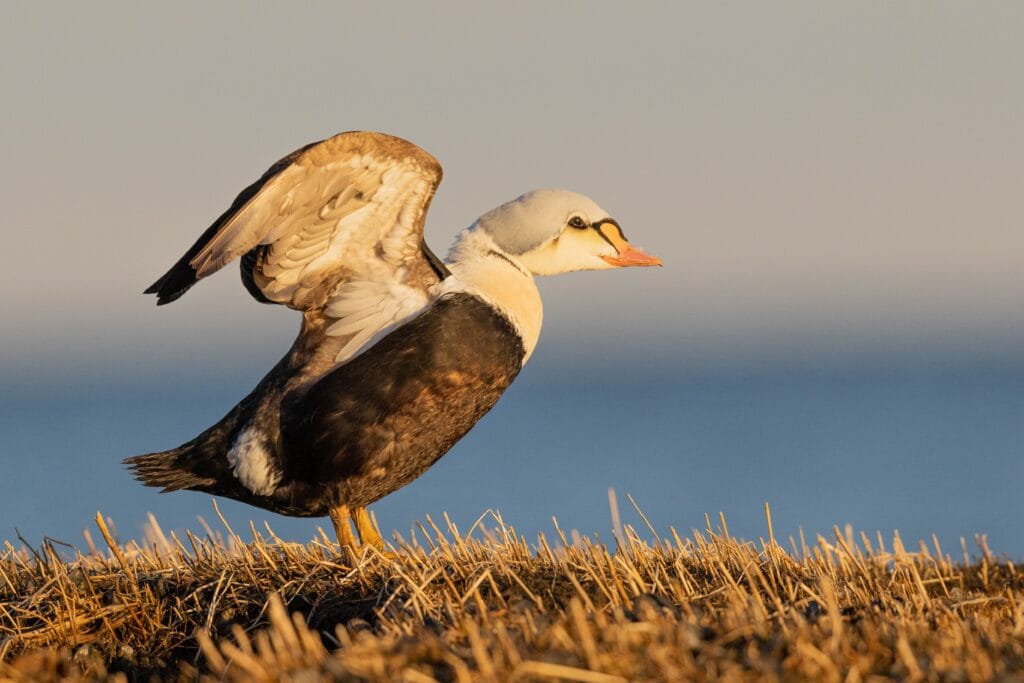Native to the cooler regions of the Northern Hemisphere, “Eider” describes three species of duck belonging to a single genus. Eiders are seaducks which spend their lives breeding and migrating along coastal regions in North America and Northern Europe. These birds are distinctive, with uniquely shaped bills which separate them from the ducks which make their homes inland. The Eider is known most of all for its luxuriously soft feathers which have been collected by humans for over a thousand years. This coveted “Eiderdown” is used to make quilts and has fostered a close relationship between humans and Eiders. (1)
The Eider is a striking animal that carries with it a sense of wild dignity. Making soft warm homes in the unforgiving tundra and spending a life subsisting off of icy northern seas is no easy task. The Eider is hearty, beautiful, and emblematic of the awe-inspiring nature of life in the frigid regions of the Arctic.
Eider Symbolism and Meaning
Eiders are most commonly associated with warmth and luxury. Eider feathers have a unique structure that, on a microscopic level, includes hooks of soft tendrils that curl back on each other trapping air and making them extremely light. Within these pockets of air, warmth remains, allowing these down feathers to perfectly insulate Eider nests which must keep eggs and chicks warm even when the ambient temperature is bitterly cold. Since ancient times, humans have collected the down from Eider nests and enjoyed the softness and heat that it provides. Eiderdown was a staple for Vikings and was even accepted as currency by medieval tax collectors, such was its perceived value. (2)
To this day, a traditional occupation persists in Nordic countries wherein farmers build cozy wooden houses in which Eiders choose to nest. At the end of the breeding season, when the birds have moved on from the nests, the farmers collect the leftover down feathers. Although the down is extremely valuable, farming it is often labor intensive and tedious. It can take as many as sixty nests to yield enough down for one duvet. (3)
So, the Eider can represent cooperation between man and nature, mutual respect, and subsistence. In addition, this bird can be seen as emblematic of ancient Nordic cultures.
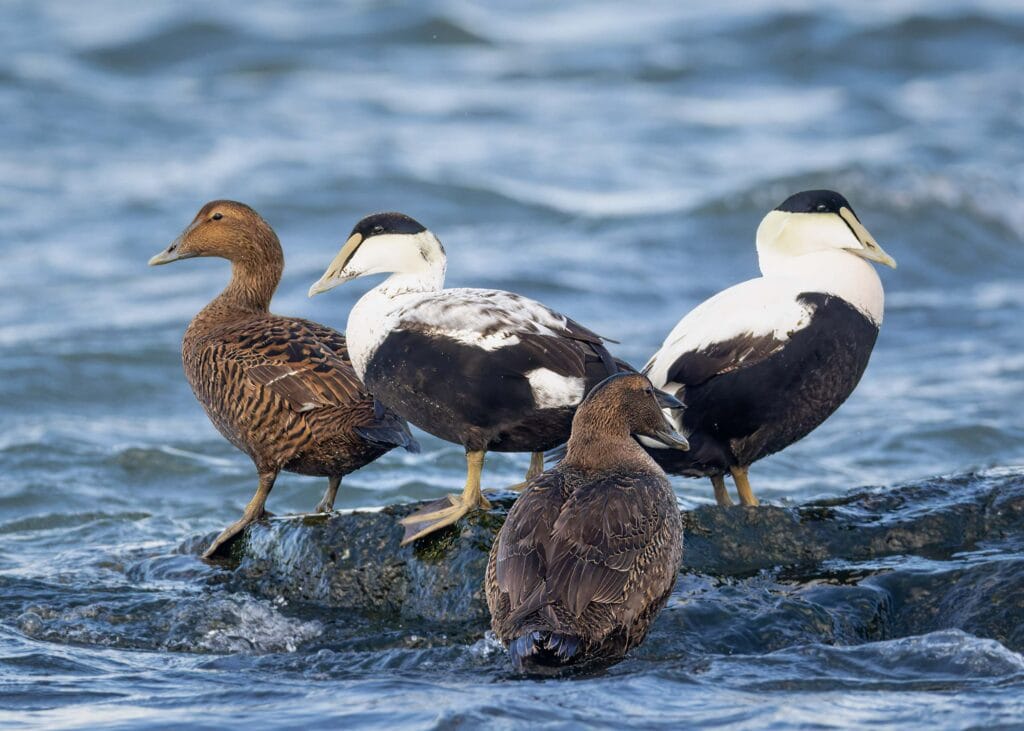
Female Eiders sit on their nests for days on end without food. When approached by potential predators, rather than abandon their young, they lay flat and blanket their nests and young with their own bodies. While some will flush off their nests if frightened enough, mother Eiders have been known to stay put to such an extent that researchers can occasionally pick them up without giving chase at all. So, the Eider represents courage, determination, motherly devotion, sacrifice, and protection. (4)
Eider Native American Symbolism
Some Iroquois myths associate the feathers of these birds with shapeshifting monsters. The Iroquois Qallupilluk monster is said to be a humanoid creature dressed in Eiderdown that lurks at the edge of bodies of water, waiting to snatch wandering children. Perhaps the Eiderdown, in this case, is meant to lure children in from the cold. (5)
Various ducks play important roles in other Native cultures as well. In many stories they are gullible animals which are taken in and deceived by trickster characters. In some Algonquin myths, though, the earth was created by a duck or a merganser, a seaduck relative of the Eider, which dove to the bottom of the sea and retrieved the mud which would form the terrain of the earth. Like mergansers, Eiders are capable of diving quite deep to retrieve the invertebrates that they eat. (6)
Eiders may represent weather, the sea, magic, and creation as well as foolishness or deception.
Eider Christianity Symbolism
Eiders do not feature in the Bible nor are they commonly used as Christian symbols. The selfless care of the mother Eider who sacrifices her own comfort, safety, and wellbeing for her young could connect these birds with the Christian values of sacrifice and unconditional love.
Eider Celtic Symbolism
Because Eiders are found in the far northern reaches of Europe, they have had no major role in Celtic cultures but have featured prominently in Nordic cultures.
Eider in Dreams
Dreaming of an Eider may represent a longing for warmth or shelter. Eiders brave harsh weather conditions, rough seas, and biting cold. They can do this because of the protective warmth of their specially designed feathers. These feathers are plucked by mother Eiders in order to provide a warm safe nest for their young. Dreaming of Eiderdown or an Eider nest may speak to an internal desire to be similarly sheltered against life’s more trying challenges.
An Eider dream may also indicate a need to look beneath the surface of a problem or adapt to life’s curveballs by changing one’s approach. Eiders can dive quite deep to retrieve invertebrates, but they will also eat vegetation and insects on land when the circumstances favor it. Diving deeply into situations can give you more perspective, but sometimes a new approach is what you really need.
Dreaming of a flock of Eider represents a homecoming. Eiders migrate throughout earth’s higher latitudes, with different locations hosting huge flocks of birds during different seasons. Dreaming of an Eider flock may indicate an urge to return to one’s home.
Eider Encounters and Omens
Encountering Eiders can be a deeply impactful experience. These birds are stunning and may require quite a bit of travel to reach for those of us who don’t live in the far north. Huge flocks of Eiders form on coastal waters in the regions that they inhabit. Encountering one of these massive flocks may symbolize community, guidance, or cycles.
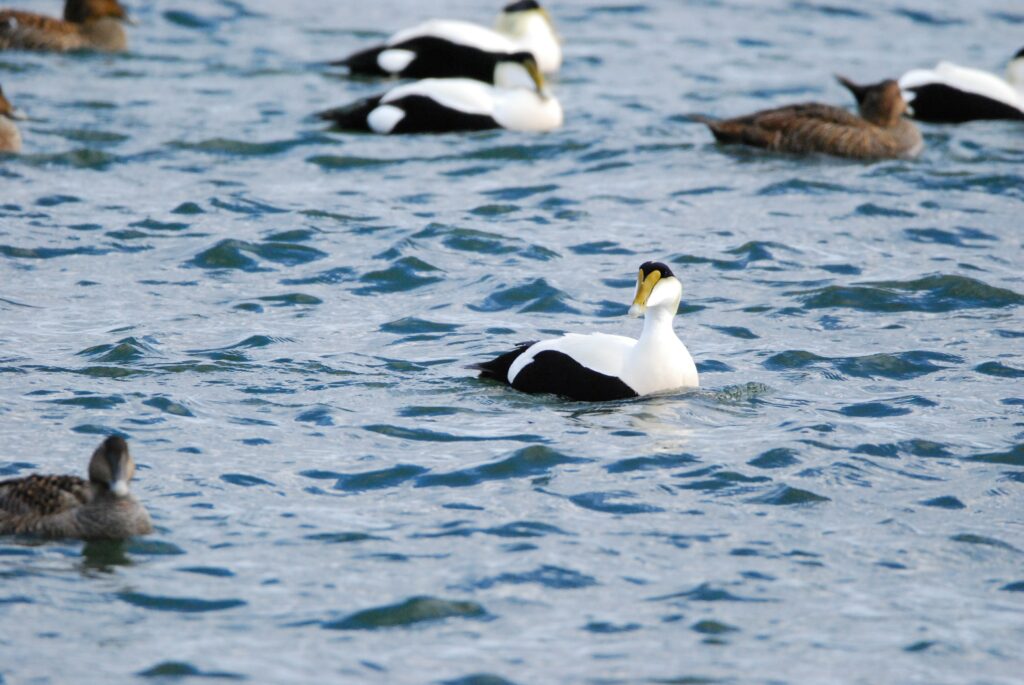
Finding an Eider’s nest would generally be considered a lucky sign, however be sure not to disturb your find unless you are a practiced Eiderdown farmer. Finding a nest with a mother Eider protecting it may be a reminder to have courage and stand your ground against that which threatens you. Eider mothers are brave animals which will stare down danger without removing themselves from their nests. Take notice of the Eider’s example and remember that you cannot always run from your problems, especially when you may leave something precious behind you. (7)
Eider in Mythology & Folklore
Eiders themselves are very scarcely involved with mythology or folklore. Eiderdown, however, is incredibly important to various Nordic cultures and is found in a few old Icelandic Sagas. (8)
Native American Mythology:
As stated above, the Iroquois monster Qallupilluk is said to be cloaked in Eiders’ feathers. Qallupilluk is said to stalk the edge of icy water waiting for children to wander too close or step out onto ice that is too thin. The legend of the Qallupilluk may have been created as a warning to keep children from playing near dangerously cold waters. According to some tales, the Qallupilluk may knock on the bottom of the ice before appearing and snatching a wayward child. Qallupilluk’s Eider garments may be a defense against the cold or a trick to lure in children. (8)
Nordic Mythology:
The Prose Edda and the Poetic Edda were written in the medieval ages but likely derived from centuries of oral traditions. The Prose Edda especially is a comprehensive source for Norse mythology which forms the background of our knowledge of this subject. To this day, though, the actual meaning of the word “Edda” is the subject of historical and linguistic debate. Proposed meanings for this word vary from “grandmother,” to “superstition,” to a variation on the name of the site where the writer of the original manuscript was written. One theory, however, suggests that “Edda” means “Eider.” Scholars point out that Icelandic manuscripts were occasionally named after birds. Some legal manuscripts from the time are connected with the word for “Grey Goose.” So, although Eiders are not major players in Norse mythology, they may actually lend their names to one of the most important documents in Norse mythology. (9)
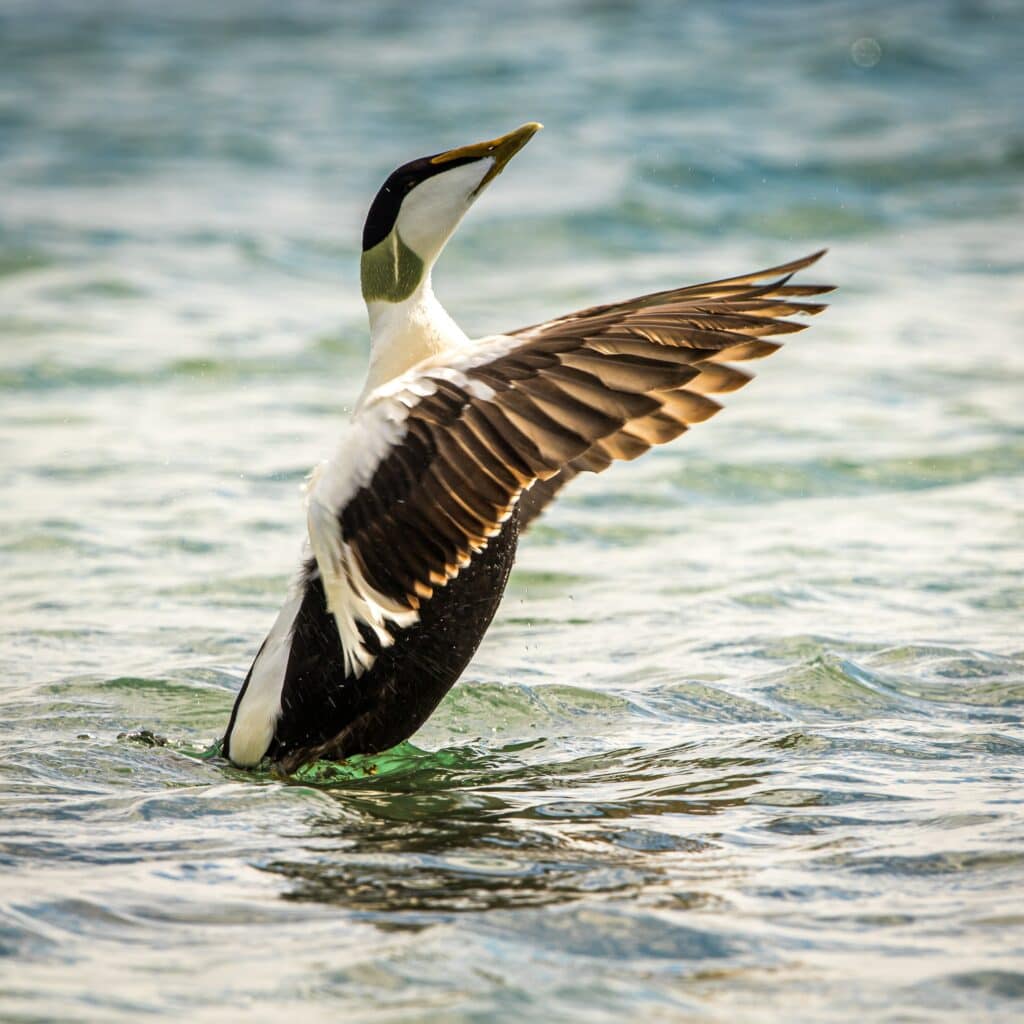
Greek Mythology:
According to Greek myth, the goddess Penelope was thrown into the sea by her father as an infant because he had desired a son and was disappointed to have a baby girl. Little Penelope was rescued by some ducks, which were likely not Eiders but were at least seaducks, and returned to her father. Repenting his earlier mistake, Penelope’s father named her for the Greek word for ducks and raised her with care. She became the wife of the hero Odysseus and was praised for her wit, wisdom, and faithfulness. She is sometimes associated with fertility and the coming of springtime. (10)
Eider Spirit Animal
If the Eider is your spirit animal then you have the grit and determination to face down almost any obstacle. No matter how cold the winter gets, how stormy the seas are, or how exhausted you become, you face what comes with a positive attitude and unwavering confidence and dignity.
People with the Eider as their spirit animal tend to be type A personalities which assert themselves without difficulty and pursue their goals relentlessly. Although this may sound a bit aggressive, they are tender at heart and generous in spirit. The Eider spirit animal knows that preparation is key and is always equipped with enough essentials to share with others.
People with the Eider as their spirit animal are protective and defensive of innocence. They do not tolerate corruption or deception and they value integrity above almost all else. The Eider spirit animal is willing to challenge anyone who threatens its peace. Even formidable foes are put off by the Eider’s refusal to back down or cower. Most of the time, the Eider spirit animal’s confidence is enough to call a bully’s bluff.
Eider Totem Animal
The Eider totem animal is associated with efficiency and productivity. Eider feathers are designed y nature to trap air and heat because of their unique structure which is unlike that of other birds’ feathers. While an Eider may not understand the value of these feathers to humans, these birds do put their incredible down feathers to good use, lining nests with them to keep their young warm and cozy. The Eider is a bird which produces lots of value and utility just by growing its own feathers.
People with the Eider as their totem animal don’t know the meaning of the word “lazy.” They aim to contribute to their community, household, and society in as many ways as possible. For people with the Eider totem, a relaxing time is not complete without a productive hobby like cooking, knitting, or building things.
Because the Eider loves to be productive, people with this totem animal may struggle to notice when they have begun to overwork themselves. Rest, real meaningful rest, is essential even for those of us who love to work or find productive hobbies relaxing. The Eider totem is a great gift, but people who have this gift may need occasional reminders to take it easy and recuperate from all the work that they do.
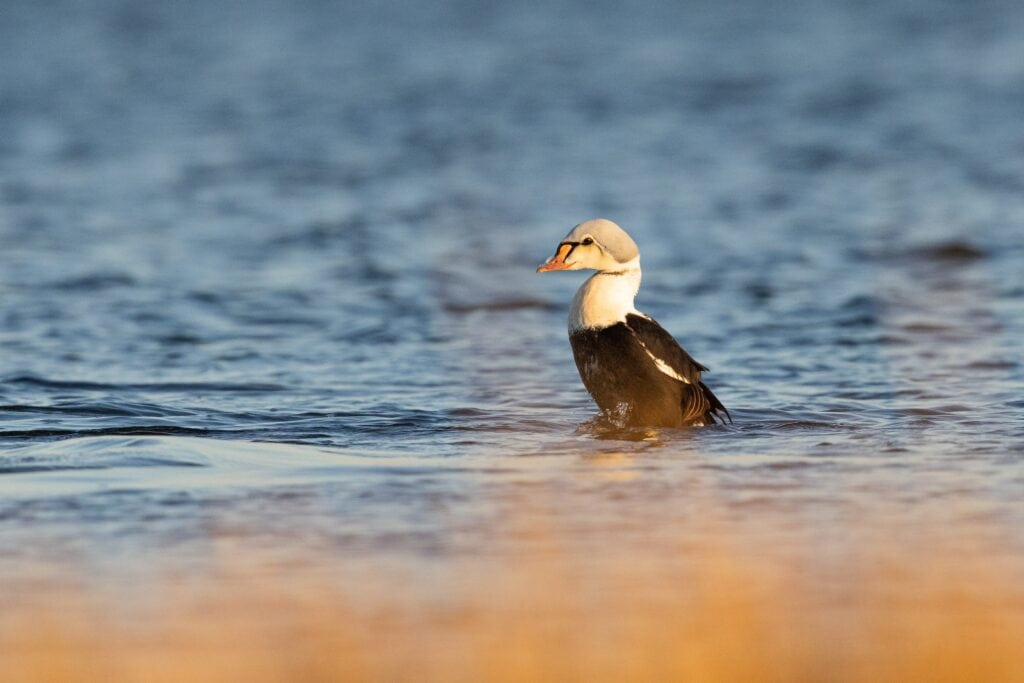
Eider Power Animal
The power of the Eider is adaptability. It takes a special bird to carve out a life in the icy tundra. Doing so on the icy Arctic seas takes an even more special one. And yet, the Eider manages to survive and thrive in these difficult regions. This is because the Eider uses its assets to the fullest. When the Eider is on land, perhaps for breeding or nesting, this duck will happily supplement its diet with vegetation or insects. At sea, the Eider dives deep to collect crustaceans and other invertebrates. When the weather is too cold for young chicks to withstand, the Eider plucks its soft feathers to shield them from the cold. These birds will even use manmade Eider houses to shelter their nests, allowing farmers to form mutually beneficial relationships that further contribute to the Eider’s success as a species.
People with the Eider as their power animal are similarly resourceful and face challenges with undaunted optimism. Honing a variety of different skills and maintaining an open mind allows the Eider power animal to find unexpected solutions to problems and adapt seamlessly.
Eider Tattoo Meaning
An Eider tattoo may be chosen to represent the wild beauty of the cold northern regions of the planet. It may also be chosen to symbolize the softness, warmth, and luxury that are synonymous with the down feathers of this exceptional bird.
An Eider tattoo may also represent determination, grit, confidence, motherly devotion, navigation, or Norse cultural traditions.
Conclusion
If you haven’t heard of the Eider then I’m happy to have had the opportunity to introduce you to this wonderful duck. From the rich history of Eiderdown and humans to the fascinating ways that these birds live, breed, and rear their young in some of the coldest regions on earth, the Eider is an animal that inspires awe and admiration.

